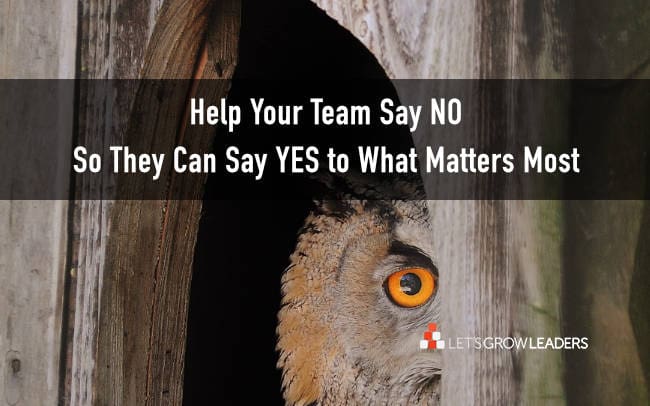Help your team say no at work so they can say yes to the work that matters most.
The ability to say “no” is critical for a person’s sense of agency or feeling in control of their life. That feeling of agency directly contributes to workplace morale, engagement, and productivity. You can help your team develop their ability to say no at work by modeling the behavior, teaching them how to say no, and supporting them when they do.
We Almost Missed It
We were in the middle of one of our favorite conversations: talking with leaders who had attended one of our long-term training programs about how they and their teams were using what they’d learned in the months and years afterward.
That’s when Shannon, a Vice President, commented on the value of a clear M.I.T. (M.I.T. = Most Important Thing).
“I love how we all have that language in common. We know what our M.I.T.s are, so when I suggest an idea, my Directors can challenge me and say, ‘How does that fit into our M.I.T.s?’ When they do that, it calls us back to center and keeps us focused.”
We love hearing how teams use a shared definition of success and focus. But Shannon and her team had taken it to the next level—and she said it so naturally that we almost missed it.
What was that next level?
Her team told her, “No.”
As in, “No, we shouldn’t do that—at least not as it’s currently presented. If it aligns and gets where we’ve all agreed we should go, then let’s talk about it, but otherwise, it’s not a great idea.”
That’s a big deal.
Know When to Say No at Work
It takes a great deal of psychological safety for performance-driven teams to tell their leader no–and it’s also a characteristic of high performance.
For your team to say yes to what matters most, they also must say no to something else. “No” is the best answer in many situations where a misplaced “yes” can sabotage relationships, goals, and well-being. Here are five times when no is a good choice:
1. Say “No” to rude, disrespectful, or unethical behavior.
It might feel easier to ignore the situation. After all, who needs more drama? But allowing a co-worker or boss to treat you with disrespect slowly undermines your confidence and sends a clear message that you’re willing to accept that behavior from him or her and any casual observers. Say “yes” to civil and ethical behavior at work.
2. Say “No” to time wasters.
Time wasters include people or activities. Say “no” to meaningless activity that doesn’t propel your mission and goals. Say “no” to the guy who’s always hanging around your cube or to mindless social media scrolling that doesn’t inform, inspire, or energize. Say “yes” to achieving your goals.
3. Say “No” to your boss’ harebrained idea.
Keep reading for suggestions on how to say no to your boss – and know that your boss will thank you for carefully putting on the brakes. Speak up. Say “yes” to shared priorities and outcomes.
4. Say “No” to negative self-talk.
It’s easy to talk ourselves out of our own success. Say “yes” to positive thinking.
5. Say “No” to scope creep.
You’ve outlined the project and the deliverables, but the “just one more” requests keep getting tagged on, without renegotiated deadlines or compensation. It’s okay to say “No, I can’t do that right now under our current terms,” while saying “yes” to “I’d be happy to talk to you about that as phase 2.” Say “yes” to renegotiation.
Why It’s Difficult for Your Team to Say No at Work
It’s not an easy thing to say no to the person with direct influence on your livelihood and career. This power imbalance costs organizations in lost talent, wasted time, accidents, and employee disengagement.
You can be the most human-centered, considerate leader and people still have their fears based on past experience or that of friends and family.
It’s not an easy thing to say no to the person with direct influence on your livelihood and career.
Three Ways to Help Your Team Say No
Helping your team say no will require you to lead the way, equip them with specific skills, and support them in their “no’s.”
1. Lead the way.
Your team is watching you. They’ll learn when and how to say no from the example you set. Do you consistently show up with confident humility and respectfully challenge your peers and your boss? Do you commit to a healthy “no” when it’s appropriate – especially when it costs you but protects your team?
Be the courageous leader your team needs by mastering a skillful “no.”
2. Help them know how to say no.
You can equip your team with several ways to say “no” at work in different circumstances.
- Say no with clear priorities.
The first way to help your team say no at work is to establish clear priorities (see Shannon’s team M.I.T.s above). When you and your team have strong, clear, shared priorities, the next step is to use them to filter every decision.
For example, “Does this help us achieve the outcomes we committed to?”
“If so, does it get us there faster or with better quality than what we’re already doing?”
If not, the no is obvious and the team can move on.
- An easy no.
In many social situations, a simple “No thank you” will suffice. No justification or explanation is needed.
- Say no by starting with yes.
In a work environment that lacks psychological safety, there is an art to saying no effectively. What if the request is from another department lead asking your team to take on a project or make room to solve a problem right away?
In these situations, your most effective “no” often starts with a “yes, and …”
Start by affirming the request and the value the request might represent—that’s the “yes.” Then bridge to the context, consequences, and decisions—that’s the “and.”
For example, “Yes, it sounds like this project would benefit our marketing strategy. And, at the moment, the team is cranking hard to meet our customer’s finish line for the new product development. I can certainly prioritize this new marketing project if we can shift the product deadline. Or, we could get this new one done after the product wraps up. My preference would be to finish up with the product so we can give this our full attention. What do you think makes the most sense?”
3. Support their no.
One of the most critical moments, as you help your team say yes to what matters most, is when they first say “no” to you or another leader.
They’ll likely do it imperfectly at first. Their “no” may lack grace. But if that “no” points toward what matters most, honor it, celebrate it, and support their decision with your peers.
You can follow up with your team privately and use it as a coaching opportunity. Help them become more skillful and navigate challenging relationships.
Are you ready to accelerate team performance?
Increase communication, connection and trust while driving results. See our Team Accelerator Program page and sign up for the free demo to learn how.
Your Turn
In healthy relationships, people honor one another’s “no.” You can help your team say yes to what matters most, by modeling how to say no, teaching them how to say no, and supporting them when they do.
We’d love to hear from you: What is one of the most effective “no’s” you’ve heard from your team or another leader?”







0 Comments